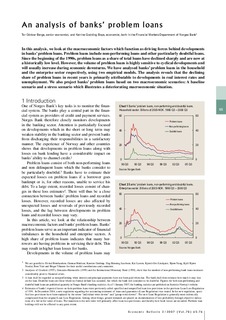| dc.contributor.author | Berge, Tor Oddvar | |
| dc.contributor.author | Boye, Katrine Godding | |
| dc.date.accessioned | 2018-07-03T13:35:57Z | |
| dc.date.available | 2018-07-03T13:35:57Z | |
| dc.date.issued | 2007 | |
| dc.identifier.issn | 0029-1676 | |
| dc.identifier.issn | 1503-8831 | |
| dc.identifier.uri | http://hdl.handle.net/11250/2504209 | |
| dc.description.abstract | In this analysis, we look at the macroeconomic factors which function as driving forces behind developments in banks’ problem loans. Problem loans include non-performing loans and other particularly doubtful loans. Since the beginning of the 1990s, problem loans as a share of total loans have declined sharply and are now at a historically low level. However, the volume of problem loans is highly sensitive to cyclical developments and will usually increase during economic downturns. We have analysed banks’ problem loans in the household and the enterprise sector respectively, using two empirical models. The analysis reveals that the declining share of problem loans in recent years is primarily attributable to developments in real interest rates and unemployment. We also project banks’ problem loans based on two macroeconomic scenarios: A baseline scenario and a stress scenario which illustrates a deteriorating macroeconomic situation. | nb_NO |
| dc.language.iso | eng | nb_NO |
| dc.publisher | Norges Bank | nb_NO |
| dc.rights | Attribution-NonCommercial-NoDerivatives 4.0 Internasjonal | * |
| dc.rights.uri | http://creativecommons.org/licenses/by-nc-nd/4.0/deed.no | * |
| dc.title | An Analysis of Banks' Problem Loans | nb_NO |
| dc.type | Journal article | nb_NO |
| dc.subject.nsi | VDP::Samfunnsvitenskap: 200::Økonomi: 210::Samfunnsøkonomi: 212 | nb_NO |
| dc.source.pagenumber | 65-76 | nb_NO |
| dc.source.journal | Economic Bulletin | nb_NO |
| dc.source.issue | 2/2007 | nb_NO |

